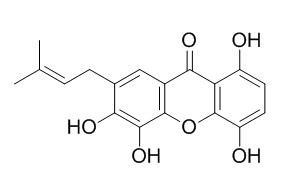1,4,5,6-Tetrahydroxy-7-prenylxanthone
1,4,5,6-Tetrahydroxy-7-prenylxanthone has anti-cancer activity, it shows moderate cytotoxicities against breast cancer (MDA-MB-435S) and lung adenocarcinoma (A549) cell lines; it also exhibits moderate activities with GI50 (Growth inhibitory) values of 2.8 μM against the human leukaemic HL-60 cell line were measured in vitro.
Inquire / Order:
manager@chemfaces.com
Technical Inquiries:
service@chemfaces.com
Tel:
+86-27-84237783
Fax:
+86-27-84254680
Address:
1 Building, No. 83, CheCheng Rd., Wuhan Economic and Technological Development Zone, Wuhan, Hubei 430056, PRC
Providing storage is as stated on the product vial and the vial is kept tightly sealed, the product can be stored for up to
24 months(2-8C).
Wherever possible, you should prepare and use solutions on the same day. However, if you need to make up stock solutions in advance, we recommend that you store the solution as aliquots in tightly sealed vials at -20C. Generally, these will be useable for up to two weeks. Before use, and prior to opening the vial we recommend that you allow your product to equilibrate to room temperature for at least 1 hour.
Need more advice on solubility, usage and handling? Please email to: service@chemfaces.com
The packaging of the product may have turned upside down during transportation, resulting in the natural compounds adhering to the neck or cap of the vial. take the vial out of its packaging and gently shake to let the compounds fall to the bottom of the vial. for liquid products, centrifuge at 200-500 RPM to gather the liquid at the bottom of the vial. try to avoid loss or contamination during handling.
Journal of Mushroom2024, 22(4):192-198
Molecules.2020 ,25(16):3697.
J Nat Prod.2018, 81(4):966-975
Biorxiv.2020, doi: 10.1101.
J Clin Med.2022, 11(13):3662.
Planta Med.2016, 82(13):1208-16
Int. Conference on Med. Sci. and Bio.2017, 17973
Mediators Inflamm.2016, 2016:7216912
Research SPJ.2024, 0377.
Eur Rev Med Pharmacol Sci.2020, 24(9):5127-5139.
Related and Featured Products
1,3,5-Trihydroxy-4-prenylxanthone
Catalog No: CFN98891
CAS No: 53377-61-0
Price: Inquiry(manager@chemfaces.com)
6-Deoxyisojacareubin
Catalog No: CFN89446
CAS No: 26486-92-0
Price: Inquiry(manager@chemfaces.com)
Ugaxanthone
Catalog No: CFN96469
CAS No: 13179-11-8
Price: Inquiry(manager@chemfaces.com)
Isojacareubin
Catalog No: CFN96573
CAS No: 50597-93-8
Price: Inquiry(manager@chemfaces.com)
1,3,6,8-tetrahydroxy-4-(3-methyl-2-buten-1-yl)-9H-Xanthen-9-one
Catalog No: CFN92541
CAS No: 1319198-98-5
Price: Inquiry(manager@chemfaces.com)
6-Deoxyjacareubin
Catalog No: CFN96276
CAS No: 16265-56-8
Price: Inquiry(manager@chemfaces.com)
1,3,7-Trihydroxy-2-prenylxanthone
Catalog No: CFN98022
CAS No: 20245-39-0
Price: Inquiry(manager@chemfaces.com)
1,7-Dihydroxy-3-methoxy-2-prenylxanthone
Catalog No: CFN97264
CAS No: 77741-58-3
Price: Inquiry(manager@chemfaces.com)
1,5,8-Trihydroxy-3-methoxy-2-prenylxanthone
Catalog No: CFN99202
CAS No: 110187-11-6
Price: Inquiry(manager@chemfaces.com)
1,4,5,6-Tetrahydroxy-7-prenylxanthone
Catalog No: CFN99016
CAS No: 1001424-68-5
Price: Inquiry(manager@chemfaces.com)
Phytochemistry. 2009 Jan;70(1):60-8.
Xanthone biosynthesis in Hypericum perforatum cells provides antioxidant and antimicrobial protection upon biotic stress.[Pubmed:
19062051 ]
METHODS AND RESULTS:
Methanolic extract of elicited cells exhibited significantly higher antioxidant and antimicrobial competence than the equivalent extract of control HP cells indicating that these properties have been significantly increased in HP cells after elicitation. Four major de novo synthesized xanthones have been identified as 1,3,6,7-tetrahydroxy-8-prenyl xanthone(1,4,5,6-Tetrahydroxy-7-prenylxanthone), 1,3,6,7-tetrahydroxy-2-prenyl xanthone, 1,3,7-trihydroxy-6-methoxy-8-prenyl xanthone and paxanthone.
CONCLUSIONS:
Antioxidant and antimicrobial characterization of these de novo xanthones have revealed that xanthones play dual function in plant cells during biotic stress: (1) as antioxidants to protect the cells from oxidative damage and (2) as phytoalexins to impair the pathogen growth.



